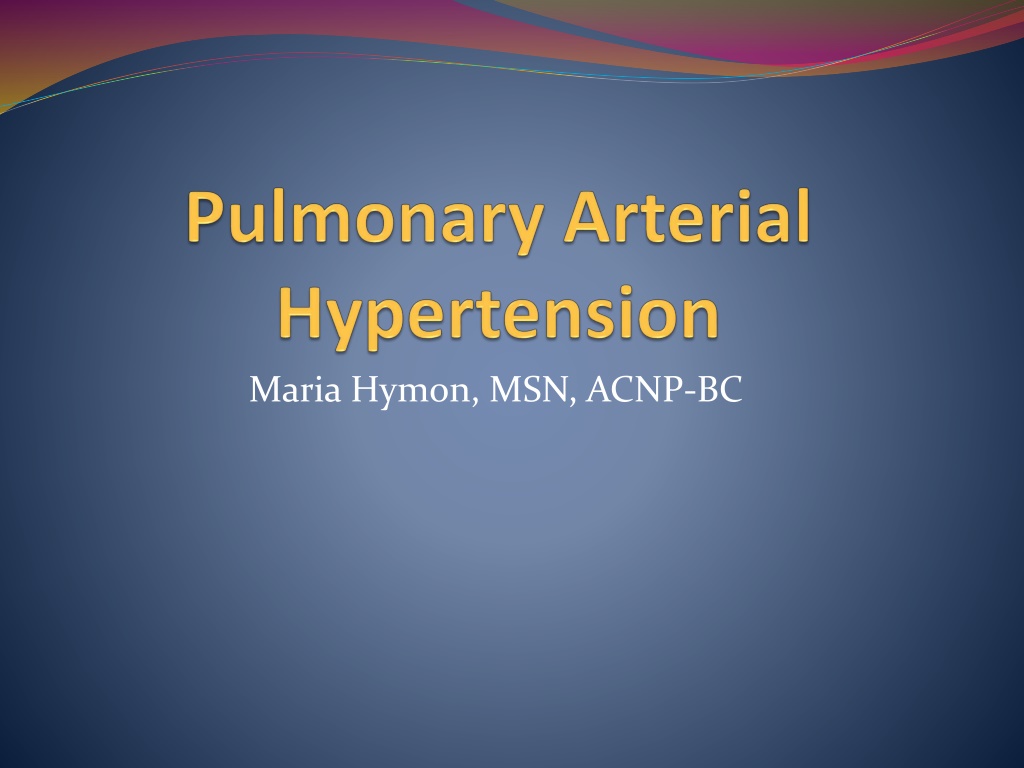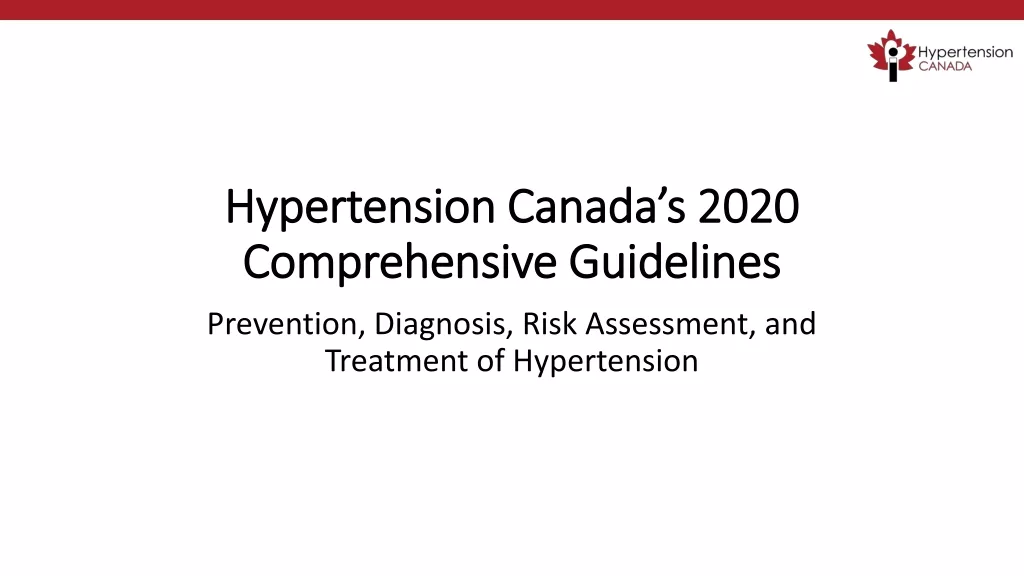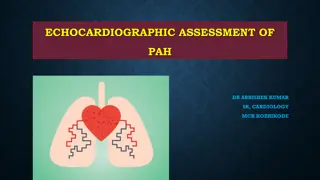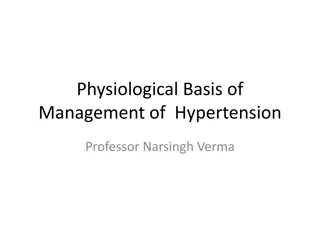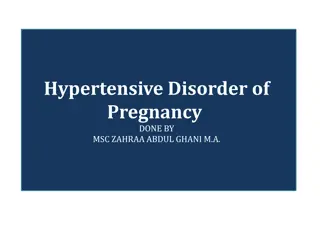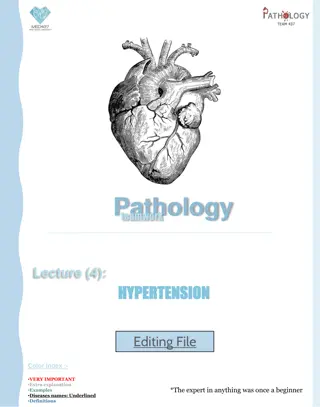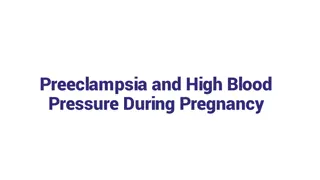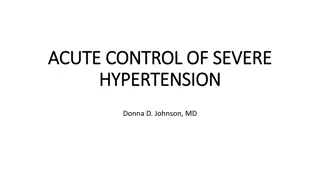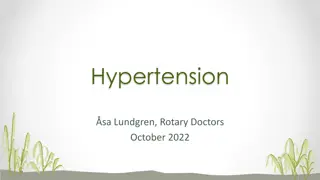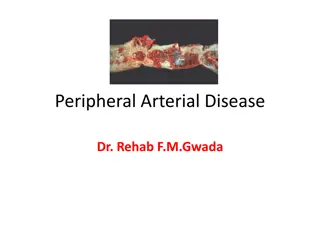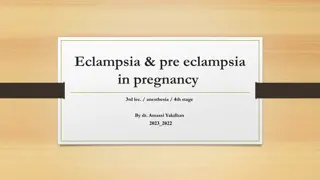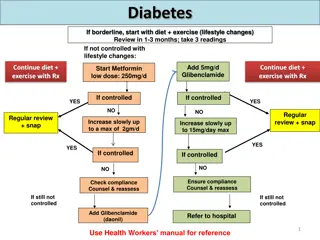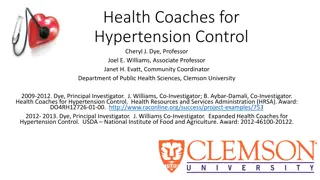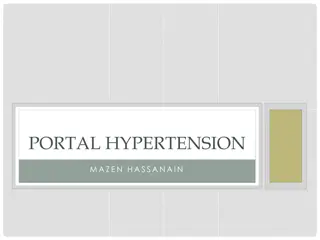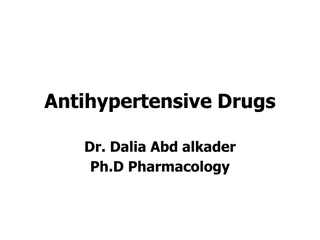Understanding Pulmonary Arterial Hypertension (PAH): Causes, Symptoms, and Management
Pulmonary Arterial Hypertension (PAH) is a progressive disease characterized by increased blood pressure in the pulmonary artery, veins, or capillaries. This condition can lead to right ventricular failure and eventual death if left untreated. PAH can have various causes, including idiopathic factors, autoimmune diseases, congenital heart issues, and more. Common symptoms include dyspnea, fatigue, chest pain, and exertional intolerance. Early diagnosis and appropriate management are crucial in improving outcomes for PAH patients.
Download Presentation

Please find below an Image/Link to download the presentation.
The content on the website is provided AS IS for your information and personal use only. It may not be sold, licensed, or shared on other websites without obtaining consent from the author. Download presentation by click this link. If you encounter any issues during the download, it is possible that the publisher has removed the file from their server.
E N D
Presentation Transcript
Definition Increased blood pressure in the pulmonary artery, veins, or capillaries Progressive disease leading to Right ventricular failure and eventual death Right Heart Catheterization Findings Mean Pulmonary Arterial Pressure 25 Pulmonary Capillary Wedge Pressure 15 Pulmonary Vascular Resistance > 3 wood units
Classification of Causes Group 1 Idiopathic & Heritable Autoimmune disease/ Connective Tissue disease HIV Drugs and toxins Portal Hypertension Congenital Heart Disease Schistosomiasis (parasitic infection) Group 2 (Left heart disease) Group 3 (lung disease) COPD Interstitial Lung disease OSA Group 4 Chronic Thromboembolic Disease (chronic pulmonary emboli) Group 5 (Miscellaneous)
WHO Group 1 PAH Common Risk Factors Family History Genetic Mutations (BMPR2) HIV Connective Tissue Disease Anorexigen use Portal Hypertension Illicit Drug Use Congenital Heart Disease Epidemiology (1) Prevalence 12 of every 1 million Americans Incidence Approximately 2 new cases per million are diagnosed yearly in US Patient Population Primarily Female (78%) (1) Mean age at diagnosis is 47 years (1) Mean time from first symptoms to diagnosis of 31 months (2)
Who Group 1 Subtypes (REVEAL Registry) Other 0.5% Familial PAH 3% Idiopathic PAH 46% Associated PAH 51% Badesh DB, et al. Chest 2010; 137(2):376-387
Associated PAH Etiologies Congenital Heart Disease 19% Other 5% CVD/CTD 50% HIV 4% Portal HTN 11% Drugs/ Toxins 11% Badesh DB, et al. Chest 2010; 137(2):376-387
Symptoms Dyspnea Fatigue Exertional intolerance Chest Pain (late) Syncope/ Dizziness (late) Palpitations Abdominal Distention
Physical Findings Peripheral Edema Ascites Loud P2 Pansystolic Murmur * Lung sounds often normal
Diagnosis Right heart catheterization is required to accurately diagnose PAH Echocardiogram is used as screening tool and to monitor treatment efficacy
Diagnosis Contd Extensive work-up completed to evaluate for all possible underlying causes PFTS, CT of Chest to r/o lung disease VQ scan to r/o chronic pulmonary embolism Blood serologies to check for autoimmune disease & HIV Nocturnal Polysomnogram (if patient has symptoms of sleep apnea)
Echocardiogram (Apical 4- chamber view) Normal PAH
Treatment Modalities targeting 3 separate pathways
Treatment Contd Phosphodiesterase Type 5 Inhibitors (PDE5 Inhibitors) Revatio (Sildenafil)- oral Adcirca (Tadalafil) - oral Endothelin Receptor Antagonists (ERAs) Letairis (Ambrisentan)- oral Opsumit (Macitentan) - oral Tracleer (Bosentan)- oral (rarely used anymore) Prostacyclins Oral Orenitram (Treprostinil) Uptravi (Selexipag) Inhaled Tyvaso (Treprostinil) Ventavis (Iloprost) IV Remodulin (Treprostinil) also available in SC (subcutaneous) form Veletri (epoprostenol) Flolan (epoprostenol)
Treatment Contd Soluble Guanylate Cyclase stimulator Adempas (Riociquat)
Monitoring Echocardiogram 6 minute walk test Laboratory data Repeat RHC if not clinically improved or declining
Question Pulmonary Arterial Hypertension is usually diagnosed within 6 months of onset of symptoms A. True B. False
Question Pulmonary Arterial Hypertension affects mostly women. A. True B. False
Question Which of the following is a late sign/symptom of PAH? A. Dyspnea B. Edema C. Syncope/dizziness D. Fatigue
Case Study #1 55 year old Caucasian female with acute onset of dyspnea. Cough, wheezing No prior past medical history except Morbid Obesity Long time smoker ( 30 years) of 2 packs cigarettes per day Denies edema, chest pain, dizziness Referred by Cardiology for Pulmonary hypertension on Echocardiogram
Case Study #1 Physical exam No JVD Diffuse wheezing in lung fields Heart regular with no murmur, rub, or gallop Abdominal exam benign No edema
Case Study #1 - Diagnostics Echo with slightly elevated RVSP (right ventricular systolic pressure) and RVID (right ventricular interdiameter) normal Ejection fraction PFTS with severe Obstruction (COPD) VQ negative for PE CT of Chest with emphysematous changes but otherwise negative Autoimmune disease work-up and HIV negative Sleep study with severe sleep apnea
Case Study #1 - Question Should patient have a right heart catheterization ? A. Yes B. No
Case Study #1 RHC results PA Mean 22 PCWP 10 PVR 1.5 wood units Cardiac output 6 liters
Case Study #1 - Question Does this patient have PAH (pulmonary arterial hypertension) ? A. Yes B. No
Case Study #1 Question What is most likely the reason for Mrs. Piggy s dyspnea? A. Overweight B. COPD C. Untreated Sleep Apnea D. None of the above
Case Study #2 48 year old African American female with progressive dyspnea over 6 months, LE edema, dizziness with ambulation, and palpitations PMH of Scleroderma (diagnosed 2 years ago) No prior tobacco use
Case Study #2 Physical Exam Mild JVD Heart Regular, no murmur, rub, gallop Lungs with scant dry crackles to bases Abdomen mildy distended with some ascites BLE with 3+ edema Taut skin
Case Study #2 - Diagnostics Echo with significantly elevated RVSP of 80 and RVID of 4.5. PFTS with moderate restriction VQ negative for PE CT Chest with early pulmonary fibrosis changes Autoimmune work-up and HIV negative except for known Scleroderma Sleep study not done due to normal BMI and no risk factors
Case Study #2 Question Should this patient have a RHC? A. Yes B. No
Case Study #2 RHC results PA Mean 65 PCWP 10 PVR 8 wood units Cardiac output 4.0 liters
Case Study #2 Question Does this patient have PAH? A. Yes B. No
Case Study #2 - Treatment What medications would you start with to treat this patient? A. Endothelin receptor antagonist (ERA) B. Phosphodiesterase Inhibitor (PDE5) C. Prostacyclin D. All of the above E. None of the Above
Case Study #2 - Question What would you use to monitor this patient s progress? Echo 6MWT Pulse Oximetry PFTS All of the above
Case Study 57 yr old AA female Comorbidities: Scleroderma Diagnosed with PAH April 2014 by RHC Symptoms Fatigue Dyspnea Peripheral edema Diagnostics CT of Chest with minimal scarring left base, small pericardial effusion VQ low probability PE Autoimmune serologies negative except highly positive ANA PFTS with Restrictive Lung disease
Case Study Before Treatment Echocardiogram - RVSP 80-85 mmHg, RVID 4.1 cm RHC PA Mean 53, PCWP 8, LVEDP 8, CO 2.3 liters 6MWT - 54 meters Patient started on Adcirca & Letairis Repeat Testing May 2014 Echo - RVSP 105-100 mmHg, RVID 3.3 cm, TAPSE 1.6 cm RHC PA Mean 50, PCWP 7, CO 3.1 liters 6MWT 162 meters Normal Values: RVID 0.8-2.6, TAPSE > 1.6
Case Study IV Remodulin intitiated Repeat Echo - RVSP 80-85 mmHg, RVID 2.8 cm, TAPSE 2.3 6MWT 54 meters Symptoms after IV Remodulin Less peripheral edema Dyspnea improved, but still present Fatigue resolving Normal Values: RVID 0.8-2.6, TAPSE > 1.6
Role of Pulmonary Rehab in PAH Research studies show that pulmonary rehab increases 6MWT distance and increases peak Vo2 Gives patients ability to network with other patients like them Aids in weight loss for some
What is important for you to know?? All PAH medications come from a specialty pharmacy and are shipped to the patient s home They are VERY expensive The only PAH medications that are on Providence hospital formulary are Remodulin % Veletri All other meds (PO & inhaled) must be brought from home Inhaled medications are delivered using special nebulizer machine that patient must bring from home
What is important for you to know?? Patients with SC or IV Remodulin cannot have their infusions disrupted Nothing else can be given through a Remodulin dedicated line SC/IV pumps should be checked on admission and daily with dose verified with pharmacy to ensure correct infusion rates There is always a number on the specialized home pump to call for any questions on what the patient s rate should be
Center for Excellence Providence Hospital will be applying to become a Center for Excellence for diagnosis and treatment of PAH in January 2015 This designation will bring nationwide recognition It is imperative that all our staff be familiar with the PAH diagnosis and all treatment modalities
